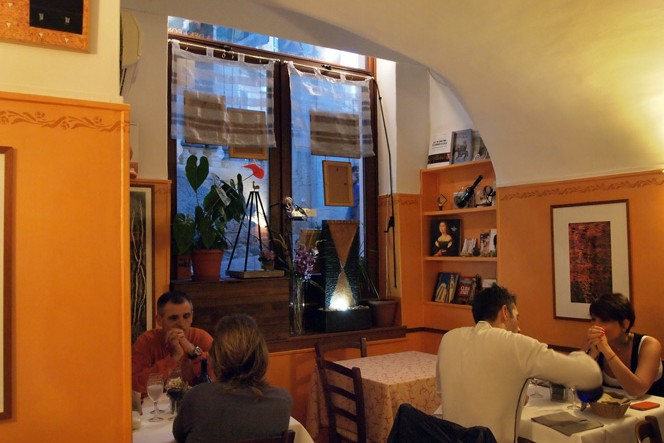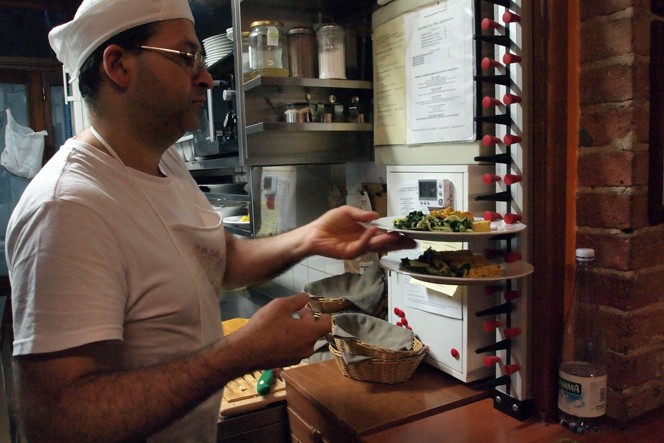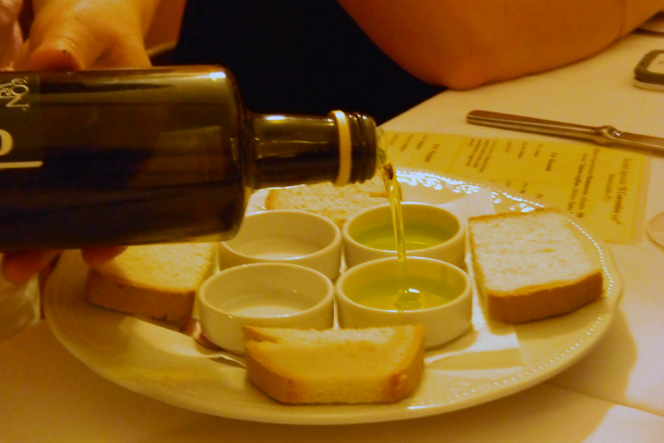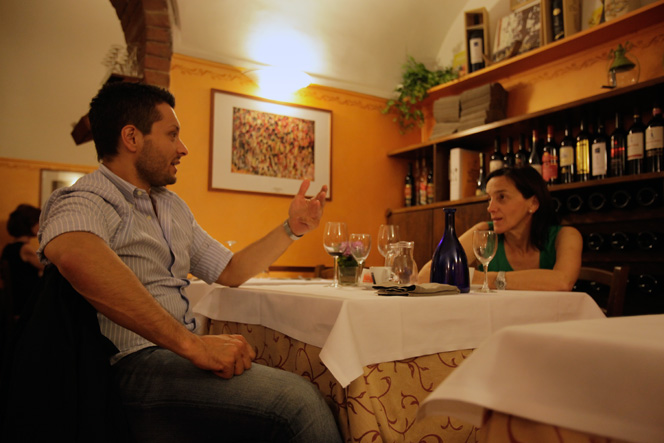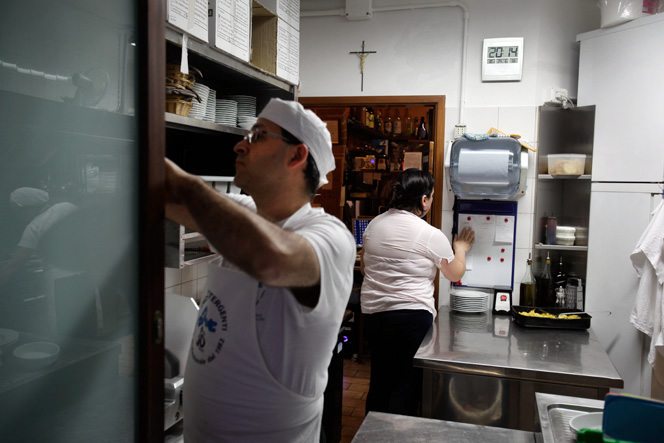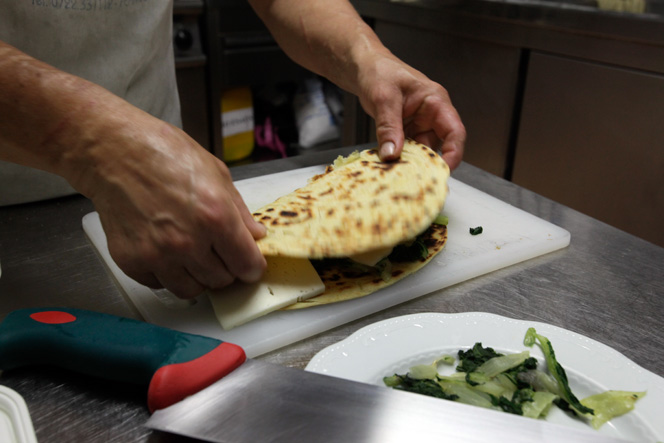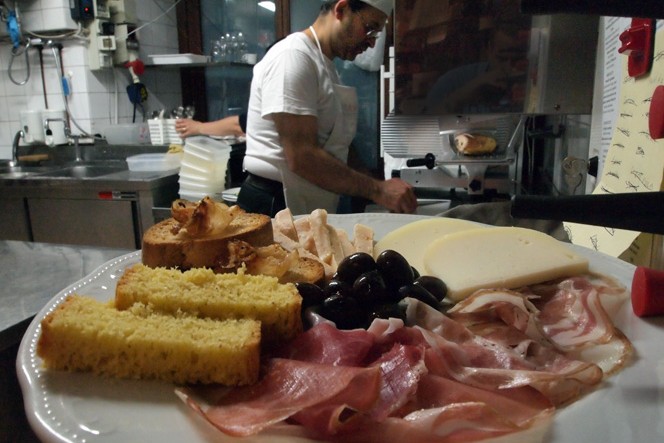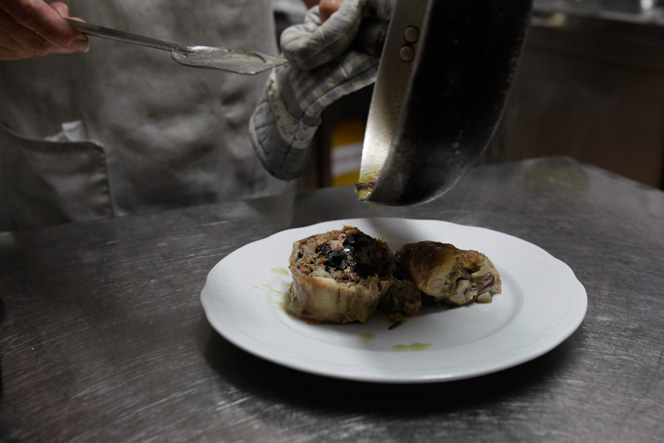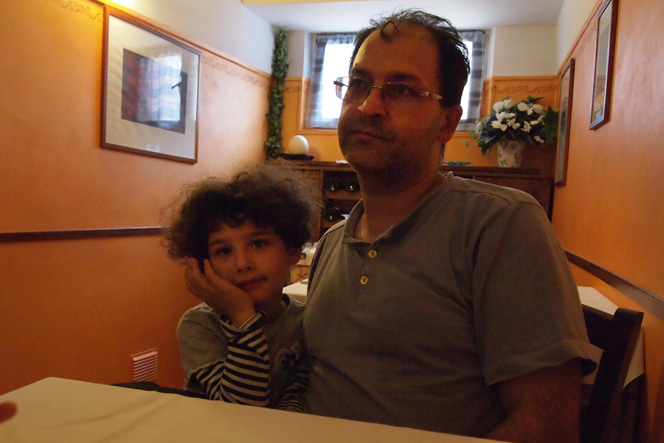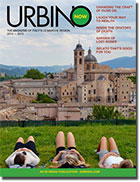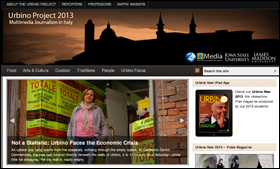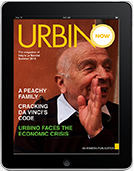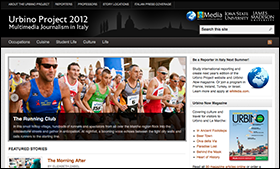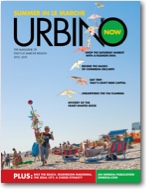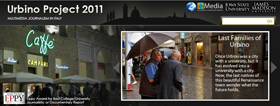The Artful Chef

Mauro Lucarini’s combination of traditional Urbino art and authentic local food creates one of the city’s most cultured dining experiences
At the end of the narrow corridor, scenes of Urbino appear, hanging from the walls of the town’s oldest restaurant. Rays beaming in from the garden-level windows cast the only light on the meticulously set tables. Empty during siesta, La Trattoria del Leone projects the ambience of an ancient art gallery rather than a fine Italian restaurant of the Marche.
Mauro Lucarini clears a table in the back dining room as his wife, Nadia, prepares a shot of espresso behind the bar. A familiar smell of egg, cheese, and breadcrumbs expands throughout the room while the broth from a steaming pot of passatelli in brodo sits in the kitchen. Large woodcut paintings tower over the tables, and every painting carries the same signature: “Mauro Lucarini.” He sits comfortably in his chair with one leg over the other and arms spread wide, surrounded by his art and his cuisine, a king in his palace.
Lucarini’s dual kingdom is grand, but it originates from humble beginnings. “There is a great connection between my dishes and my artwork,” Lucarini says. As owner and designer of Urbino’s eldest restaurant for over 10 years, Lucarini aims to connect his guests to the town not solely with dishes, but equally with the décor. The woodcut paintings, created by a technique know as xilografia, line the walls of the restaurant and ally with the menu that serves nothing but regional products to immerse customers in the town’s culture deeper than any tour guide or history book.
“They represent myself and the landscapes of Urbino,” Lucarini says of his artwork. His style carries no common theme, with inspiration coming entirely from Lucarini’s own experiences in the Urbino region. La Trattoria del Leone displays paintings of the Marche region featuring towers in Ascoli and archways in Urbino’s Piazza della Repubblica, which are just a few steps outside the restaurant. The pieces range from several dense gouges and brightly colored paintings, to longer incisions and darker colorings. Lucarini says he lets the past speak for itself.
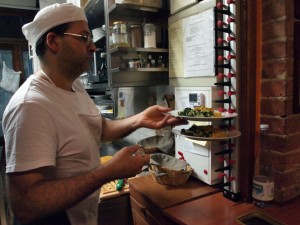
Lucarini, who specializes in regional dishes made with ingredients from local producers, sets a pair of dishes on a holding rack for a waiter to deliver.
In Clessidra 2, which translates to “Hourglass 2,” two yellow triangles meet at their peaks and create an hourglass appearance to form a single figure in the foreground. The background begins as a light blue at the top of the vertical painting, then transitions almost unnoticed into a dark blue towards the bottom, similar to a clear day’s sky with a storm in the distance.
In Morte Seconda, “Second Death,” Lucarini offers a variety of emotion with one of his darkest xilografia paintings. The mixture of black and grey evokes an eerie feeling of a dark forest. The texture xilografia conjures is blatant as horizontal lines cover the frame looking similar to bark on a burned tree. The natural curves in the painting appear to be a detailed close-up of the wood inside a tree trunk.
He explains that xilografia has its roots in Urbino as far back as the 15th Century. “Xilografia was very popular in Urbino between the Middles Ages and the Renaissance,” Lucarini says. “They used this style to print images of saints and holy figures and gave the images to people who were not able to read so they could be close to God.” He says that the University of Urbino still teaches the traditional style of engraving today and is the only school in the country that is still doing so.
“The first step of xilografia regards cutting the wood,” Lucarini says. A version of printmaking, xilografia is relief printing where engraved wood is painted, then transferred to paper by pressing. “It is called elevation printing,” Lucarini says. The wood that is engraved creates the white space.
Lucarini began practicing xilografia at age 15 when he was in high school. From there he graduated from the University and began his career as an artist. Years later, Lucarini and Nadia bought the restaurant after visiting for lunch one day. “We were here when I was looking for a lab near the center of the city,” Lucarini says. “We stopped in La Trattoria to have lunch and my wife knew the owner. When talking with him [the previous owner], he says that he would like to retire and that my wife and I were the right people to take over the restaurant.” Lucarini saw the restaurant as a beneficial alternative to just finding a new studio. His newly acquired restaurant not only doubled as his gallery, but it also allowed Lucarini to express himself through a new avenue of food.
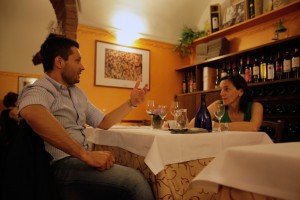
Friends enjoys an evening in La Trattoria del Leone beneath Lucarini’s artwork named “Composizione.”
One of Lucarini’s final paintings before he opened the restaurant, Fuga A Sud, reflects the period of transition he went through. “This is the sea and this is the earth,” Lucarini explained while pointing to the painting. A jagged blue coastline frames the left side of the bird’s eye view painting of a sea. The water features several wave-like swirls, reminiscent of Vincent Van Gogh’s Starry Night. An evident, sharp black arrow pierces through the right half of the sea, exits the painting, and points to the bottom of the frame. “The line represents an escape,” Lucarini says. “I knew I would be very busy after I opened the restaurant so I couldn’t work on art as much.” A circle representing the cardinal directions sits near the bottom of the painting outside the frame of the sea and confirms the direction ‘Sud.’
His art production has been slowed by the restaurant recently, but Lucarini remains compelled to manage his restaurant. “This restaurant has a great impact on Urbino,” Lucarini explained. “I would like to impress people and tourists with the local products and by showing what Urbino has to offer.”
Lucarini proudly displays a list of 30 products originating throughout the Marche that comprise the ingredients used in La Trattoria del Leone’s traditional menu. “My favorite product is the local oil I use,” Lucarini says. “The oil plays a very important part in the cooking.” Assaggio di olii monovarietali is La Trattoria del Leone’s tasting appetizer of four different oils from “Il Conventino” which is in Monteciccardo, a small city outside of Urbino. The popular oil antipasti is served with a basket of fresh bread. The waiter explains the characteristics while pouring each of the four oils.
Tagliatelle, Lucarini’s favorite dish, is a simple pasta with olive oil and bread crumbs. The long-time Marche dish isn’t your typical wet Italian pasta that slips off of the fork. The abundant breadcrumbs soak up the rich oil and allow all of the noodles to stick together, forming a seemingly single unit for easy cutting.
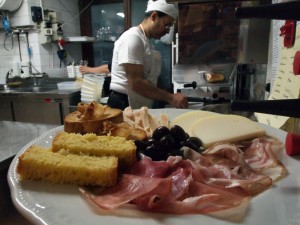
Antipasto di prodotti locali, an appetizer of local meats and cheeses, sits ready in the holding rack as Lucarini starts on the next order.
Coniglio in porchetta, roast rabbit with black olives, and passatelli, the egg-cheese-breadcrumb pasta served in broth, are also among traditional Urbino favorites served. While Trattoria perpetuates customary dishes, the restaurant also gives customers like Antonella Rampulla other reasons to keep coming back. “My favorite is casciotta with vegetables,” Rampulla says. Casciotta is a popular Urbino cheese. “Many places in Urbino serve casciotta alone or with ham, but only La Trattoria del Leone serves it with cooked vegetables.” Adding its own twist on Urbino cuisine, coupled with the location just off of the main Piazza, helps spell longevity for the restaurant. Founded circa 1920, it is closing in on 100 years in business.
The name La Trattoria del Leone, “The Restaurant of the Lion,” originates from a fountain in close proximity to the restaurant that once had a lion statue in it prior to being destroyed during the Second World War.
“I was impressed by the environment,” Rampulla says of her first experience at the restaurant. “The owner and his wife are very nice people and they create a comfortable ambience.” Rampulla noted that the artistic décor is what makes it her favorite restaurant. “There are many artists in the city but only a few are good. One day I would like to have Mauro’s art in my home.”
Since taking over the restaurant over 10 years ago, Lucarini’s goal of expressing himself through his life in Urbino has been steadfast. “The other day a couple came in to eat,” Lucarini explained. “They asked me if I was the artist of all of the paintings. When I responded yes, they claimed they knew I had to be the artist—because they somehow could tell that the food and the art were all connected.”
This article also appears in Urbino Now magazine’s La Gente section. You can read all the magazine articles in print by ordering a copy from MagCloud.



